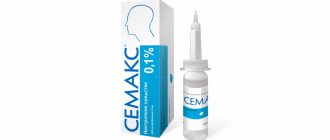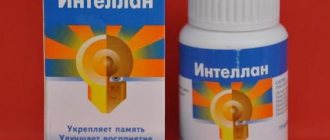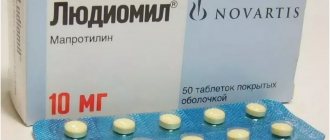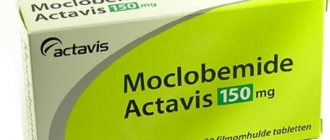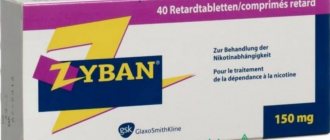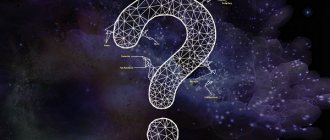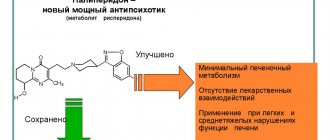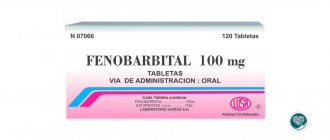For various problems with cerebral circulation, pathologies of the cardiovascular system and the central nervous system, there is a need to use nootropics.
One of the popular remedies is Gliatilin .
Compound
The basis of the composition is the chemical compound choline alphoscerate.
The area of action of the component extends to choline receptors in the central nervous system.
To ensure that the product is better absorbed by the body, the active ingredient is supplemented with:
- esithol;
- sodium ethyl parahydroxybenzoate;
- gelatin;
- sodium propyl parahydroxybenzoate;
- sorbitans;
- metahydroxide;
- titanium dioxide, iron.
To produce a liquid form, the active ingredient is supplemented with glycerin and liquid in the form of purified water.
Price for the drug Gliatilin
In the absence of Gliatilin in the pharmacy, the drug can be replaced with no less effective analogues with the same active ingredient:
- Choline alfoscerate. Sold in the form of a solution for intramuscular or drip administration. Each ampoule contains 250 mg/ml of active substance, ampoules are 4 ml each. There are 10 pieces in a package. The cost of this analogue is slightly higher than 550 rubles per package.
- Nooholin Rimpharm. Ampoules do not differ in volume and content of active substance. There are usually 3 ampoules in a package, the cost of the drug in the described dosage is from 350 rubles per package.
- Cereton. Available in capsules, each dose unit contains 400 mg of the active ingredient. A package of 56 capsules costs an average of 1,400 rubles. The solution for intravenous and intramuscular administration is packaged in 4 ml ampoules, each of which contains 0.25 ml of the substance. A pack of 5 ampoules can be purchased for 580 rubles.
- Holitylin 400 mg. Sold in capsules, 28 or 14 pieces per package. The dosage and number of doses does not differ from the prescribed regimen for taking Gliatilin. The cost of a package containing 14 doses varies from 405 rubles.
- Cerepro. It can be found both in ampoules and capsules. The amount of active substance in 1 dose does not differ from what is contained in analogues. A package of 28 capsules is sold at a price of 1,000 rubles.
Pharmacology
The therapeutic effect with high effectiveness is ensured due to the physical and chemical properties of the constituent chemical compounds.
Among the main ones:
- influence on systemic blood flow by accelerating blood circulation;
- activation of metabolic functions;
- stimulation of the reticular formation;
- restoration of lost functionality in case of various types of injuries (damage to brain tissue).
The nootropic corrects the factors of involutional psychoorganic syndrome.
This process is based on the suppression of cholinergic activity, as a result of which the amount of phospholipids in neuronal membranes changes.
Choline alfoscerate easily passes through the morphological structures of the brain, increasing the concentration of the active component mainly in the tissues of the brain, liver and lungs. Under the influence of metabolic processes, the substance is converted into carbon dioxide, after which it is excreted from the body through the intestines and kidneys.
Principle of action of Gliatilin
The action of the drug is aimed at neural connections in the human brain. After being absorbed into the blood, the active substance, choline alfoscerate, reaches the brain, where it enters into chemical reactions. As a result of the formation of bonds, glycerol phosphate and choline are released. During the biotransformation process, phosphatidylcholine and acetylcholine are synthesized. The first substance increases the elasticity of cell membranes and their permeability. And the second substance is one of the most important nerve mediators.
Taking Gliatilin activates blood circulation processes in the brain, which ensures rapid restoration of lost functions. Most of the substance is eliminated by the respiratory system, along with carbon dioxide. Residues - with waste products.
Price and release forms
The cost of the medicine depends on the form of release and dosage:
- Capsules (400 mg, 14 pcs.) – price in the range 720-780 rub..
- Oral solution (600 mg/7 ml, 10 units) – price 520 rub..
- Injection liquid (1000 mg, 4 ml ampoules, 3 units) – price range 565-630 rub..
You can buy a nootropic drug both in a pharmacy chain and in an online store.
One of the main conditions for dispensing a pharmacological product is the availability of a prescription.
When placing an order through an online pharmacy, you have the option of purchasing the medicine without a prescription.
Directions for use and doses
Injections: IM or IV (drops).
Capsules: orally, before meals.
Adults, in acute conditions: IM - at a dose of 1000 mg/day (1 amp.) or IV - 1000-3000 mg/day. For intravenous administration, the contents of 1 amp. (4 ml) diluted in 50 ml of saline, infusion rate - 60-80 drops per minute. The duration of treatment is usually 10 days, but if necessary, treatment can be continued until positive dynamics appear and it is possible to switch to oral capsules.
For chronic cerebrovascular insufficiency, changes in the emotional and behavioral sphere and multi-infarct dementia: orally - 400 mg (1 capsule) 3 times a day.
Duration of therapy is 3–6 months.
Indications for use
In medicine, nootropic medicine is used for the following pathologies:
- disturbances of visual memory, speech functions;
- syndromes characterized by a decrease in intelligence, memory and other degenerative damage (when the cause of their development is cerebrovascular insufficiency);
- decreased cognitive activity, dementia.
The drug is highly effective in correcting psycho-emotional states, behavioral disorders, and other central nervous system pathologies.
Gliatilin is included in complex therapy to eliminate the consequences that arise from traumatic brain injuries (in the acute phase), when the patient experiences loss of consciousness, a coma, and focal hemispheric symptoms.
Other uses of the medicine:
- for strokes to relieve acute symptoms;
- for rehabilitation after a stroke (promotes the restoration of physical skills and consciousness).
The neuroprotector is also used in therapy for children.
It is considered justified to use the medicine for the following problems:
- neuroses, nervous tics;
- autism;
- ADHD;
- hydrocephalic syndrome;
- cerebral palsy;
- with mental retardation, mental retardation;
- with birth injuries of the brain;
- during labor hypoxia.
Instructions for use
The injection liquid is designed to administer medication using a needle via the IV or IM route.
Intravenous injections (droppers) are performed with preliminary dissolution of 1 ampoule of the drug with 50 ml of saline solution.
The speed of liquid movement through the system is 80 drops/min.
- Treatment of acute forms of diseases begins with intramuscular injections. The daily dose is 600-1000 mg. Sometimes it is rational to use intravenous medication (up to 3000 mg).
- As soon as there is a positive trend in the patient’s condition, a switch to tablets is made. This takes on average 5-10 days.
The development of a treatment regimen and determination of dosage is carried out exclusively by medical staff. The doctor also has the right to make adjustments to the treatment process if necessary.
The neuroprotector in capsules is taken orally. Taking time: 40-60 minutes before meals.
The treatment regimen involves taking the medicine 2-3 times, 1 tablet each, for 3-6 months (the duration of the course depends on the etiology of the disease, the intensity of its development, and the patient’s condition).
Instructions for use for children:
- It is better to take the medication in the morning before breakfast;
- You need to take the whole tablet only with purified water (100-150 ml);
- when prescribing intravenous drip infusions, the drug is pre-diluted with saline solution;
- IM injections are given into the muscle tissue (the shoulder or femoral part is most often involved);
- injection time – up to 12-14 hours.
For TBI, it is recommended to use 1 ampoule per day for 1 week. After this, a transition to capsules is made (1 unit twice a day for 2 months).
The duration of therapy for birth trauma/hypoxic encephalopathy is about six months. For 10-12 days, injections are given once a day (1-2 ml). The daily norm for children 1-3 years old can increase to 2-3 ml, for the age group over 3 years old - 4 ml. The next stage of therapy is the use of tablets. Capsules are used according to the following scheme: 1 pc. 2 times a day. After 2-3 months, treatment can be adjusted by a specialist under whose supervision the patient is.
Patients and methods
In accordance with the purpose of the observational program, we for the period from February to August 2021 on the basis of the audiology department of the State Budgetary Institution "Research Clinical Institute of Otorhinolaryngology named after. L.I. Sverzhevsky" DZM examined and treated 40 patients with bilateral chronic NCT that arose against the background of cerebrovascular pathology.
The duration of the disease ranged from 4 to 15 years (average 6.7±2.42 years); The age of the patients was from 49 years to 72 years (on average 63.4±2.53 years), there were 28 women, 12 men.
Main inclusion criteria
The patients in the study were: 1) the age of the patients was 40 years and older;
2) the patient has bilateral NCT (symmetrical or asymmetrical increase in hearing thresholds in both ears by bone and air conduction) of vascular etiology, subjective non-pulsatile tinnitus; 3) informed consent of the patient to participate in the clinical observational program; 4) the patient’s ability to adequately cooperate. The exclusion criteria
for patients before starting therapy were: 1) signs of dysfunction of the auditory tubes; 2) mixed form of hearing loss; 3) pregnancy and lactation; 4) individual intolerance to the active substance and auxiliary components of the drug Gliatilin; 5) acute and chronic diseases in the acute stage of other organs and systems. Individual intolerance, as well as all types of allergic reactions in connection with taking the drug Gliatilin, increased tinnitus and hearing impairment, regardless of the cause-and-effect relationship with taking Gliatilin, and patient non-compliance were criteria for excluding patients from the observation program during the treatment period.
We conducted a comprehensive examination of all patients, including otorhinolaryngological, audiological, otoneurological, neurological, as well as magnetic resonance imaging of the brain and computed tomography of the temporal bones.
The otorhinolaryngological examination included the collection of complaints, analysis of the medical history and life, as well as examination of the ENT organs (anterior and posterior rhinoscopy, oroscopy, meso- and hypopharyngoscopy, indirect laryngoscopy, otoscopy (diagnostic and therapeutic ENT combine BASIC PLUS, Germany). Everyone patients underwent otomicroscopy using an operating microscope (Spectra 500 research and operating microscope, Germany) with 8- and 16-fold magnification (0, 10, 40, 70, 100 days of the study).
During the study, the following indicators were studied over time:
1. Subjective assessment of ear noise in points on the Tinnitus Handicap Inventory (THI) scale and visual analog scale (VAS) from 0 to 10 points (0, 10, 40, 70, 100 days of the study).
2. Results of subjective and objective methods for studying the state of the auditory analyzer: speech (whispered and spoken speech) and tuning forks (tuning forks C128, C512; Weber, Rinne, Federici, Bing tests) studies; tone threshold and speech audiometry, noise metry (“comparison and overlap method”) (audiometer GSI-61, Grason-Stadler, Inc., USA), acoustic impedance metry (impedance audiometer Titan, Interacoustics, Denmark) (0, 10, 40, 70 , 100th day of the study).
3. Assessment of the neurological status of patients: intensity of headaches, pathology of cranial innervation, pyramidal signs, cerebellar signs, emotional disorders, memory impairment, sleep disturbance (0, 10, 40, 70, 100th days of the study).
4. Assessment of anxiety and depression using the Hamilton scales and the SCL-90 symptom questionnaire (0, 10, 40, 70, 100 days of the study).
5. Assessment of cognitive functions according to the Montreal scale (Moka test) (0, 10, 40, 70, 100 days of the study).
6. Identification and registration of side effects of the drug (0, 10, 40, 70, 100 days of the study).
All patients received complex therapy including the drug Gliatilin. All patients were divided into two groups depending on the method of administration of the drug Gliatilin:
Group 1 (20 people) received 3 ml Gliatilin solution intravenously for 10 days, then 400 mg Gliatilin capsules 3 times; Group 2 (20 people) received a Gliatilin solution 3 ml intravenously for 10 days, then an oral solution 600 mg 2 times a day for 3 months.
Side effects
In the course of a study conducted to study the effect of choline alfoscerate on the human body, rare cases of side effects were identified.
At the initial stage of therapy, nausea, mild confusion, and epigastric pain may appear.
The doctor who is seeing the patient is informed about unpleasant symptoms. The specialist will adjust the dose, select an analogue, and make other changes to the treatment course.
Stroke is one of the leading causes of mortality and disability in the population [1, 2]. The increase in the incidence of stroke is associated with leading risk factors - cardiovascular pathology, chronic stress, poor nutrition, bad habits, aging population, etc. [1].
The most effective treatment for ischemic stroke in the first hours of the disease is thrombolytic therapy. However, the frequency of its implementation remains low and does not exceed 10% (in most European countries this figure is approximately 3%), which is largely due to the narrow time frame of the “therapeutic window” [15]. In this regard, research aimed at studying possible mechanisms for prolonging the life of brain tissue in the ischemic penumbra zone and, accordingly, increasing the therapeutic window, as well as determining treatment tactics for patients who, for one reason or another, are not subject to thrombolysis, are relevant.
Neuroprotective therapy is considered as one of the promising areas of complex treatment of patients with acute cerebrovascular accident (ACVA) [14]. To date, a large number of studies have been conducted on the use of neuroprotective drugs in patients with ischemic stroke, but their results are ambiguous [5-7, 13, 16]. It can be assumed that the reason is the design flaws of the clinical trials: the choice of an inadequate therapeutic window, untargeted selection of patients taking into account the pathogenetic variant of stroke and other features of the disease, the use of obviously insufficient dosages of drugs and the duration of their administration, the choice of endpoints with low sensitivity and overestimation of the possible effect therapy [8, 10]. In this regard, modern clinical guidelines for the treatment of acute neurological diseases do not recommend neuroprotective therapy for use. At the same time, based on empirical experience, as well as within the framework of our own protocols, drugs with neuroprotective activity are widely used in many medical institutions.
One of the drugs that has neuroprotective and neurotrophic effects is choline alfoscerate (gliatilin). When choline enters the body, alfoscerate is broken down by enzymes into choline and glycerophosphate. Choline is involved in the biosynthesis of acetylcholine, one of the main neurotransmitters; glycerophosphate is a precursor of phospholipids (phosphatidylcholine) of the neuron membrane. Thus, gliatilin enhances cerebral cholinergic conductivity and has a positive effect on the plasticity of neuronal membranes [11]. Some experience has been accumulated in the use of choline alfoscerate in patients who have suffered stroke, but there is still insufficient data on its effect on the rehabilitation process of patients with stroke [3, 4, 9, 11, 12, 14].
The purpose of this study is to evaluate the effect of choline alfoscerate on the dynamics of restoration of lost functions and the final results of neurorehabilitation measures in patients with hemispheric ischemic stroke.
Material and methods
We examined 60 patients, 37 men and 23 women (average age - 64.7±15.2 years) in the acute period of hemispheric ischemic stroke.
Patients were randomized into 2 groups of 30 people each. Both groups were comparable in terms of gender, age, severity of the disease, and comorbidities. Patients of the 1st (main) group, in addition to unified stroke therapy, received intravenous injections of gliatilin 1000 mg per day for 10 days, followed by switching to oral administration of the drug in the form of capsules 400 mg 3 times a day for 20 days. Gliatilin therapy was started no later than 12 hours after the onset of stroke. Group 2 (comparison) consisted of patients who did not receive gliatilin.
Unified therapy for stroke included: correction of respiratory disorders, blood pressure, glucose levels, water-electrolyte balance, body temperature, nutrition, secondary prevention (antithrombotic, lipid-lowering, antihypertensive therapy, correction of other risk factors) and complex rehabilitation treatment (physical therapy from the earliest possible verticalization, physiotherapy, massage, robotic mechanotherapy, classes with a speech therapist and neuropsychologist).
All patients upon admission were examined according to a standard procedure. The diagnosis of ischemic stroke was verified by CT/MRI data of the brain. The pathogenetic variant was clarified using laboratory tests, duplex scanning of the brachiocephalic arteries, transcranial Doppler sonography, bilateral Doppler monitoring of the middle cerebral artery with embolodetection, ECG, including Holter monitoring echocardiography. The severity of the neurological deficit was assessed using the NIHSS scale, the functional state was assessed using the Rankin scale and data from neurophysiological research methods (EEG, somatosensory evoked potentials - SSEP on the 1st, 10th, 20th and 30th days of therapy.
Patients who underwent thrombolytic therapy were not included in the study.
results
After a 30-day course of therapy, the severity of the condition and the degree of functional recovery in patients of the two groups were compared. After a 30-day course of treatment, the severity of stroke on the NIHSS scale decreased by 50.8% (from 12.8±4.6 to 6.1±1.2 points, p
<0.05) in patients of the 1st group and by 36.8% (from 12.1±5.8 to 9.1±1.8 points,
p
>0.05) in patients of the 2nd group.
The difference between the initial and final indicators was significant ( p
<0.05) only in the group of patients receiving gliatilin.
When studying the dynamics of the functional state on the Rankin scale on the 30th day, there was an improvement in indicators by 45.4% (from 3.9±0.2 to 2.0±0.5 points, p
>0.05) in patients of the 1st group and by 34.5% (from 3.6±0.3 to 2.4±0.5 points,
p
>0.05) in patients of the 2nd group.
Patients of group 1 were statistically significantly more likely to achieve their rehabilitation goals ( p
<0.05). Thus, rehabilitation goals were achieved after complex therapy in 79% of patients in group 1 (33% moved independently, 41% moved with assistance or using a walker, 14% were adapted to a wheelchair, 12% remained bedridden) and only in 38% of patients in group 2 (15% moved independently, 25% moved with assistance or using a walker, 39% were adapted to a wheelchair, 21% remained bedridden).
A study of SSEPs after therapeutic measures in patients of two groups revealed an increase in the amplitude and a decrease in the latency of the N20 cortical response. These changes were more pronounced in group 1, but the differences did not reach the level of statistical significance (Table 1)
.
When conducting transcranial magnetic stimulation before the start of therapeutic measures, an unstable cortical response with a reduced amplitude of less than 1.5 μV was induced in all patients in the area of the affected hemisphere. On the 30th day of therapy in patients of group 1, the cortical response was recorded more regularly and its amplitude increased to 2-2.5 μV. In patients of group 2, the amplitude of the cortical response increased slightly (to 1.6-1.7 μV).
In 27 (90%) patients of group 1, by the 10th day of the disease, the most complete normalization of the EEG pattern was determined in the form of a significant regression of interhemispheric asymmetry in the α-range and minimal severity of slow-wave activity in the projection of the focus of cerebral ischemia. In patients of group 2, even on days 20-30, residual changes were revealed in the form of a persistent focus of slow waves in the projection of ischemia, interhemispheric asymmetry in the α-1 range with a predominance of power in the intact hemisphere.
According to control Doppler ultrasound, on the 30th day in patients of the two groups there was an increase in linear blood flow velocity (LBV) and a decrease in indices of peripheral vascular resistance on the side of the lesion, which indicates increased perfusion in the affected vascular system. Despite the fact that these changes did not reach the level of statistical significance, a similar trend was more pronounced in patients of group 1 (Table 2)
.
The study showed that the use of choline alfoscerate (gliatilin) no later than 12 hours from the onset of ischemic stroke leads to a significant regression of the severity of neurological symptoms and the achievement of set rehabilitation goals. A more pronounced increase in cerebral perfusion in the affected vascular system during administration of choline alfoscerate may be a consequence of neurometabolic activation and increased plastic processes in the ischemic zone. Stabilization of neurophysiological parameters while taking gliatilin did not reach reliable values, but occurred in a shorter time and in a larger volume.
Thus, this study assessed the effectiveness of early neuroprotective therapy with the drug gliatilin in patients with hemispheric ischemic stroke, and also studied the dynamics of the clinical status of patients, the speed and completeness of restoration of lost functions, and the success of solving rehabilitation problems. In addition, an assessment was made of the cerebral hemodynamics of the affected hemisphere and the dynamics of neurophysiological parameters (EEG, SSEP, TMS).
Patient reviews
Albina:
I came across a lot of information about the drug Gliatilin on the forums, but reviews for children are sparsely presented. I decided to share my experience of using a nootropic, which I gave to my child for neurosis. Therapy lasted 4 months (1 capsule per day). Positive dynamics became noticeable after 10 days.
A month later, the child looked absolutely balanced, despite the not always adequate behavior towards him of his peers. I did not observe any side effects throughout the treatment period.
Victor, 37 years old:
After a TBI at the plant, he underwent serious treatment using several drugs. Gliatilin was prescribed to restore lost physical skills and cognitive processes. After a couple of weeks, I felt the first improvements: irritability disappeared, speech became clear and understandable, and concentration increased. No side effects were observed when using the capsules.
Reviews from neurologists
A. P. Stepanov, work experience 22 years:
Gliatilin shows high effectiveness in therapy after stroke attacks, TBI, and CVD. In combination with other pharmacological agents, it is possible to quickly restore lost functionality and cope with disturbances in the blood circulation of the brain. Long-term use of the drug reduces cognitive deficits.
Features of using the nootropic: due to increased excitability, it is recommended to take it before lunch time to avoid negative effects on healthy sleep. Efficiency increases with course therapy, which involves the use of injections at the initial stage, then capsules.
Tatyana Mikhailovna Kuznetsova, practicing specialist with 12 years of experience:
Gliatilin is an effective neuroprotector, as proven by reviews from adults on forums. The opinions of doctors who use psychotropic drugs in their practice do not disagree with them. A high therapeutic effect is achieved with asthenia, VSD, cerebral palsy, etc.
The availability of different forms of release is also considered convenient, which allows you to achieve the desired result with minimal stress on the liver and kidneys.
International Neurological Journal 5 (43) 2011
In recent years, the number of cerebral strokes (MI) has been progressively increasing throughout the world, primarily due to ischemic disorders of cerebral circulation [1–3]. In the coming decades, WHO experts expect a further increase in the number of cerebral strokes [4–7]. This is due to the increase in the global population of older people and the significant prevalence of such risk factors for MI as arterial hypertension, heart disease, diabetes mellitus, obesity, smoking, etc. [8–10]. The problem of MI is also relevant in Ukraine, where about 110 thousand people suffer from stroke every year, of which 35% are people of working age [11].
Stroke is the leading cause of death and disability in developed countries. Only 10–20% of patients return to work after a stroke. About 25% of disability in the adult population is caused by stroke [1, 6].
According to stroke registries, 20–43% of patients after MI require outside care, 33–48% experience hemiparesis, and 18–27% have aphasic disorders [8–10]. The consequence of this is huge economic losses, which, according to some estimates, amount to 4% of the health budget of developed countries [5]. For example, in France, the cost of post-stroke care for 1.5 years per patient is 19,513 euros [5].
The number of cases of chronic cerebral circulatory disorders, which lead to the development of cerebral stroke or dementia, is also growing worldwide [8, 9, 11].
The increasing incidence of cerebral stroke and the associated high level of disability determine the urgency of the problem of effective treatment of patients with vascular diseases of the brain [12, 13].
The main goal of therapy for ischemic stroke in the recovery period is to restore the functional integration of the central nervous system (CNS) and eliminate the neurological deficit. During this period, when morphological infarct changes in the brain substance have already formed, reparative therapy using means aimed at improving the plasticity of undamaged brain tissue and interneuronal interaction is becoming increasingly important. Such drugs include neuroprotectors that have trophic and modulatory properties that enhance regenerative and reparative processes, promoting the restoration of impaired functions. They have a direct activating effect on brain structures, improve memory and cognitive functions, and also increase the resistance of the central nervous system to damaging influences [12, 14–16].
The main tasks of neurorehabilitation of patients who have suffered a stroke are reduced to restoration of impaired functions, mental and social readaptation of patients, prevention of post-stroke complications (spasticity, contractures, etc.). Early onset (in the acute period), duration and systematicity, complexity, phasing, as well as the active participation of the patient and family members determine the success of rehabilitation measures [17]. The rate of recovery of impaired functions is influenced by many different factors: the age of patients, the severity of the stroke, the location of the lesion, concomitant diseases, the start of rehabilitation measures, the time and quality of medical care, and others [18]. Recently, a lot of data have appeared indicating the role of cognitive and affective disorders that have a negative impact on the effectiveness of rehabilitation in post-stroke patients. Cognitive impairment occurs, according to various authors, in 22–77% of patients within a year from the onset of stroke. At the same time, cognitive impairment reaching the level of dementia is detected in 25–34% of patients [19–22].
Thus, cognitive impairment, along with other consequences of stroke, make a significant contribution to the social and everyday maladaptation of patients after a stroke. Post-stroke cognitive disorders are usually called disorders of memory and other higher brain functions that arose or reached clinical significance in the first months after a stroke. The main causes of cognitive impairment in patients after cerebral ischemic stroke may be damage as a result of stroke to strategic parts of the brain for cognitive activity, the development of a multi-infarction state, extensive lesions of the white matter (leukoaraiosis), concomitant neurodegenerative diseases, and depression [23].
Cognitive impairments have a negative impact on the rehabilitation process, increase disability and significantly worsen the quality of life of patients, as well as people who care for them.
Treatment of patients in the post-stroke period is a complex task due to the diversity of pathobiochemical and pathophysiological mechanisms underlying it.
There is evidence in the literature about the positive effect of neuroprotectors on the effectiveness of recovery after a stroke [15, 16, 24, 25].
Some of the most effective drugs among neuroprotectors are derivatives of exogenous choline: CDP (citicoline), GPS (choline alfoscerate (Gliatilin)), recognan.
Gliatilin (alpha-glycerylphosphorylcholine, alpha-glycerylphosphorylcholine) is a compound containing 40% choline and is converted in the body into a metabolically active form - phosphorylcholine, which can penetrate the blood-brain barrier and activate the biosynthesis of acetylcholine in the presynaptic membranes of cholinergic neurons [26].
Animal experiments have shown that Gliatilin prevents induced cholinergic deficiency, prevents the development of dementia, facilitates learning and memory processes by increasing the synthesis and release of acetylcholine in brain structures [27].
Another mechanism of action of Gliatilin is the anabolic effect, manifested in the stimulation of membrane and glycerolipid synthesis due to the formation of membrane phospholipid precursors from the products of its metabolic breakdown [27, 28].
Thus, Gliatilin activates cholinergic neurotransmission, increasing the plasticity of brain tissue, and has a membrane-stabilizing and antioxidant effect.
We analyzed a number of clinical studies on the use of choline alfoscerate in patients with various vascular diseases of the brain.
Pilot clinical studies of Gliatilin in the acute period of severe ischemic stroke (intravenous administration at a dose of 1 g 3–4 times a day for 5 days) revealed an “awakening” effect of the drug (Fig. 1). There was a decrease in the severity of respiratory and circulatory disorders, improvement in cerebral oximetry, and positive dynamics of brainstem evoked potentials to acoustic stimulation, which indicated normalization of the functional state of the brainstem. A beneficial effect of Gliatilin on the mental activity of patients, memory, and restoration of speech functions was also noted [29–33].
The results of an extensive multicenter 3-year study of the capabilities of Gliatilin in 800 patients with acute ischemic stroke in leading clinics of the Russian Federation deserve special attention [29]. According to the results obtained, when administering the drug from day 1 to 90 (days 1–15 - 200 mg/day, days 15–30 - 100 mg/day, then - 800 mg/day) that by the 30th day of administration, patients receiving Gliatilin showed a significant increase in the ability to self-care (less than 2 points on the Rankin scale); by the 90th day, a decrease in neurological deficit was significantly more often noted (less than 2 points on the NIHSS scale ) (Fig. 2). It is important to emphasize that the noted clinical parameters of improvement correlated with neuroimaging data on the volume of the lesion: in the group of patients receiving Gliatilin, by the 30th day there was a minimal increase in the volume of cerebral infarction.
A study conducted by a group of Italian scientists (F. Amenta et al., 2010) showed that the use of the drug Gliatilin caused a significant improvement in cognitive function in patients with mild to moderate forms of Alzheimer's disease [34].
Italian scientists Lucilla Parnetti, Francesco Amenta, Virgilio Gallai reviewed scientific data regarding the clinical effectiveness of choline alfoscerate, a precursor of acetylcholine, which was used to treat dementia [35].
The information presented was obtained by summarizing data obtained during thirteen clinical trials, which included 4054 patients with ischemic stroke, with various forms of vascular dementia, including dementia of the Alzheimer's type, as well as in the treatment of acute cerebrovascular accidents (Fig. 3). The results of these studies showed a positive effect of the drug Gliatilin on cognitive functions in the patients studied.
Numerous studies have been conducted that have demonstrated the effectiveness of Gliatilin in relation to motor disorders, level of consciousness, and cognitive disorders in patients in the acute period of cerebral stroke (Fig. 4). At the same time, the effectiveness and safety of the drug Gliatilin in patients during the recovery period of ischemic stroke is of scientific interest.
An open study of the effectiveness and tolerability of choline alfoscerate in patients in the recovery period of ischemic cerebral stroke was conducted at the Department of Vascular Pathology of the Brain of the State Institution “Institute of Neurology, Psychiatry and Narcology of the National Academy of Medical Sciences of Ukraine”.
The purpose of the study was to determine the effect of the drug Gliatilin on the severity of neurological deficits, indicators of daily vital activity and the state of cognitive functions in the recovery period of ischemic stroke.
Research objectives:
1. Assess the effect of the drug Gliatilin on the main subjective manifestations of the disease in patients in the post-stroke period.
2. Assess the dynamics of objective neurological symptoms of the disease as a result of treatment with Gliatilin.
3. To study the effect of the drug Gliatilin on cognitive functions in the examined patients.
4. Determine the effect of the drug on daily life activities and quality of life indicators.
5. Assess the tolerability of the drug Gliatilin, identify possible side effects, including analyzing the effect of Gliatilin therapy on the general condition of patients who have suffered an ischemic stroke.
The study included 20 patients in the recovery period of ischemic cerebral stroke, aged 45–75 years, who were treated in the department of vascular pathology of the brain of the Institute of Neurology, Psychiatry and Narcology of the National Academy of Medical Sciences of Ukraine. All patients received the study drug Gliatilin at a dose of 1000 mg IM once a day for 14 days, then 400 mg (one capsule) 2 times a day for 2 months.
To solve the research objectives, the following examination methods were used in the work: clinical-neurological; psychodiagnostic (MMSE scale); the level of daily life activity, as well as the degree of disability of patients, was determined using the Rankin scale; the functional state of patients and their ability to self-care were assessed using the Barthel index; The quality of life of patients was determined using the SF-36 questionnaire.
The diagnosis was made based on a study of patient complaints, life and illness history data, neurological and somatic status.
Among the examined patients, in 15 (75%) patients, the middle cerebral artery basins were involved in the pathological process, and in 5 (25%) patients, the vertebrobasilar basin was involved. In 8 patients, the focus of ischemia was localized in the right hemisphere, in 7 - in the left.
To verify the diagnosis of ischemic stroke and determine its subtype, CT or MRI of the brain, Doppler ultrasound, duplex scanning of the carotid arteries and electrocardiography were performed. According to the mechanism of development, 12 patients suffered atherothrombotic stroke, 6 patients suffered cardioembolic stroke, and 2 patients suffered lacunar stroke.
In patients who suffered MI in the middle cerebral artery system, complaints of weakness in the contralateral limbs, numbness and sensory disturbances in these limbs prevailed. In patients with left hemisphere carotid disorders, speech disorders in the form of motor and sensory, amnestic aphasia were noted. For patients who suffered a stroke in the vertebrobasilar area, complaints of persistent dizziness, mainly when changing body position, turning the head, noise, ringing in the head and ears, nausea, difficulty swallowing, dysarthria, and visual disturbances were more typical.
During an objective examination, all patients had diffuse organic symptoms in combination with focal disorders. Oculomotor disorders predominated: weakness of convergence, limited upward gaze, insufficiency of the abducens nerves. The patients had asymmetry of the facial muscles, nystagmus in extreme abductions, disturbances in statics and coordination, aphasic, motor (of varying degrees of severity), sensory (mainly in the hemitype), tone disorders, anisoreflexia, mainly in the hemitype, decreased strength in the limbs (contralateral to the lesion ). A group of symptoms was identified: decreased corneal reflexes, swelling of the tongue with teeth marks, pain in the eyeballs when pressed, which were regarded as indirect signs of cerebrospinal fluid hypertension.
In addition, the patients exhibited reflexes of oral automatism, pathological signs, and anisocoria.
Focal neurological symptoms corresponded to the affected vascular system and the location of the ischemic focus.
Analysis of subjective and objective neurological symptoms made it possible to identify the leading clinical syndromes.
Focal neurological syndromes were observed in 75% of cases. The symptoms corresponded to the localization of the ischemic focus, the affected vascular system.
Vestibuloatactic syndrome was observed in 80% of patients, characterized by dizziness, unsteadiness when walking, aggravated by looking at moving objects and changing body position, accompanied by disturbances in statics and coordination, ataxia in the Romberg test.
Cephalgic syndrome occurred in 95% of cases. It was characterized by severity, monotony and uniformity of headache.
Liquor-hypertensive syndrome occurred in half of the patients. It was characterized by persistent headaches of a bursting nature, with a feeling of pressure on the eyeballs, nausea, and caused the development and aggravation of neurological symptoms of a secondary brainstem nature (oculomotor disorders, pyramidal signs, pathological reflexes, pseudobulbar disorders). The presence of hypertension syndrome was confirmed by fundus examination data, CT data, and indirect EEG and ultrasonography signs.
Asthenic syndrome was observed in all examined patients. It is presented mainly in the form of a pronounced component of physical and mental fatigue and decreased sensory tolerance.
We assessed the dynamics of neurological symptoms and syndromes before and after treatment with Gliatilin. As can be seen from the data presented in table. 1, under the influence of treatment with Gliatilin, a weakening of the severity of syndromic neurological symptoms is noted.
As a rule, corresponding positive changes in patients began to appear after 2 weeks of treatment with the study drug, and subsequently the reduction of neurological and somatic symptoms increased.
As can be seen from table. 1, therapy with Gliatilin contributed to a significant reduction in the quantitative severity and occurrence of almost the entire list of objective and subjective symptoms. In most patients, the severity of complaints decreased from 4 points to 1–2 points, and in 2 patients there was a complete reduction in their complaints.
During treatment, there was a decrease in the severity of asthenic syndrome and pseudobulbar disorders. In some patients, a reduction in focal neurological syndromes was observed (improvement in motor functions, speech, vestibuloatactic syndrome).
The state of cognitive functions before and after treatment with Gliatilin was assessed using the MMSE scale. Before treatment, the overall cognitive performance score on the MMSE scale was 24.3 ± 1.8 points. There was a pronounced narrowing of the volume of verbal memory and counting operations. The examined patients were characterized by disturbances in the sphere of attention and signs of dysfunction of the frontal lobes (impulsivity, uncriticality, perseveration). Memory impairments in these patients were combined with other cognitive disorders - defects in stability and switching of attention, impaired criticism, behavior, etc. First of all, short-term memory suffered, its volume decreased, and an increase in inhibition of short-term memory traces was detected.
The dynamics of indicators on the MMSE scale before and after treatment are presented in Table. 2.
Analysis of the dynamics of cognitive functions during the treatment of patients showed a statistically significant improvement in all indicators of the cognitive sphere (memory, attention, orientation, counting functions). In patients after treatment, the overall indicator of cognitive productivity was 26.1 ± 1.9 points.
Analyzing the results of a psychodiagnostic study, it should be noted that in the majority of patients, under the influence of treatment with Gliatilin, cognitive functions significantly improved, mental performance increased, and memory and attention indicators improved.
The score dynamics of the functional state of patients in the recovery period of ischemic stroke and their ability to self-care, assessed using the Barthel index, are presented in Table. 3.
At the beginning of the study, the average Barthel index score in patients in the recovery period of ischemic stroke was 55.0 ± 5.0.
During the therapy, after 2 weeks (14 ± 2 days), and then after 1.5 months (44 ± 3 days), all patients showed an improvement in their functional state, the average Barthel index during this period increased by 14.5 points and was 69.5 points.
By the end of treatment, after 2.5 months (74 ± 3 days), the Barthel index in the examined patients was within the range of 78.5 ± 2.5, it increased by 23.5 points compared to the initial visit.
The degree of disability according to the Rankin scale over time during treatment with Gliatilin in patients in the recovery period of ischemic stroke is presented in Table. 4.
As can be seen from table. 4, at the beginning of the study, the level of disability on the Rankin scale in patients in the recovery period of ischemic stroke was 3.4 ± 0.2 points.
During treatment with Gliatilin, there was a decrease in the degree of disability of patients, which was characterized by a decrease in scores on the Rankin scale, which indicated an improvement in the functional capabilities of patients in the post-stroke period.
The results of a clinical study of the effect of a course of Gliatilin on the dynamics of quality of life indicators are presented in table. 5.
As a result of testing for all indicators of the SF-36 quality of life questionnaire, after Gliatilin therapy, quality of life parameters were significantly higher than before treatment. Almost all the basic values of the subdomains of the SF-36 questionnaire exceeded the 50-point barrier, which indicated that patients achieved a better quality of life.
Thus, the indicator “physical activity” (physical exercise tolerance) and the indicator “the role of physical problems in limiting life activity” increased significantly. Patients reported increased internal energy and enthusiasm when performing their normal daily duties. During treatment with Gliatilin, sensitivity to some manifestations of physical pain decreased; it had less of an effect on behavior, activity and the amount of work performed. Patients also rated their overall perceived health and vitality significantly higher.
Improvement in general physical condition also had a positive effect on awareness of one’s mental health, since for most patients psychological status is closely related to physical and functional status. Patients noted an increase in their social activity; they received satisfaction from the opportunity to maintain contacts with others. We can talk about a decrease in the degree of fixation on negative emotions, when patients felt useless and helpless, and an increase in the possibility of expanding the social and psychological world.
During this clinical study of patients in the recovery period of ischemic stroke, 4 cases of adverse events were recorded. One patient had an acute respiratory viral infection; this adverse event was not related to the study drug. Two patients experienced mild nausea, which went away on its own without adjusting the dose of the drug; one patient experienced a metallic taste during the infusion. In none of the patients did the manifestation of a side effect require discontinuation of treatment.
The drug did not have a negative effect on the main indicators of cardiac activity and hemodynamics (blood pressure and heart rate): at the end of the study, the patients showed no significant changes in heart rate and blood pressure.
The administration of the study drug also did not have any negative impact on the indicators of the morphological composition of peripheral blood, on the levels of its main biochemical constants characterizing the functional state of the liver and kidneys, and also did not affect the indicators of clinical urine analysis.
The study showed that the use of the drug Gliatilin in a dose of 1000 mg IM once a day for 14 days, then 400 mg (one capsule) 2 times a day for 2 months in patients in the recovery period of ischemic stroke allows accelerating the recovery of neurological functions , including reducing focal neurological symptoms.
It should be noted that the therapeutic effects of the drug Gliatilin are aimed at correcting disorders of higher cortical functions. These effects include restoration of concentration and memory, improvement of mental and physical performance, the emotional state of patients, and improvement of cognitive functions.
A course of use of the drug Gliatilin in patients during the recovery period of ischemic stroke has a positive effect on their quality of life.
The drug is well tolerated by patients and does not cause any clinically significant side effects when taken long-term for 2.5 months.
Thus, the drug Gliatilin, when prescribed at a dose of 1000 mg IM 1 time per day for 14 days, and then 400 mg (one capsule) 2 times a day for 2 months, can be recommended for use as a treatment for patients with recovery period of ischemic cerebral stroke.
Analogues of the drug
Any drug that is developed based on choline alfoscerate is hypothetically suitable for therapy.
In fact, a specialist chooses an analogue taking into account several important factors.
The most effective medications are:
- Cerepro;
- Nooholin Rompharm;
- Delecite;
- Cereton;
- Holitylin;
- Gleazer.
For children, the doctor suggests:
- Anvifen (capsules) – recommended from 3 years of age, active substance – aminophenylbutyric acid;
- Cortexin (in injection ampoules) – can be included in therapy for premature babies;
- Aminalon (in tablets) – the composition contains GABA, used from 1 year;
- Pantogam (in the form of syrup) - the composition is based on hopantenic acid, the drug is suitable for any age;
- Nootropil (various forms) - the composition is developed on the basis of piracetam, used from the age of one.
The selection of an analogue is carried out by a qualified specialist who takes into account the properties of the medicine and its area of influence on the health of a particular patient.
Recovery after a stroke
Brain recovery after stroke
Currently, when considering the processes of brain recovery after a stroke, special attention is paid to the ability of phospholipids (substances that make up the membranes of neurons) and deacetylated phospholipids to maintain the integrity of the membranes of nerve cells through the restoration of phospholipid synthesis and acetylcholine synthesis in the damaged brain.
Compounds with such properties are called neuroprotectors (protecting neurons). In addition to neuroprotectors, patients who have suffered a stroke are prescribed drugs to restore cerebral blood flow, as well as symptomatic therapy and other drugs (depending on the period of the disease, the causes of the stroke and its clinical picture). It is extremely important to start treatment for stroke as early as possible: in the first hours of the disease!
Stroke Recovery Tools
Neuroprotectors used as means for recovery after a stroke fully include substances that are sources of choline and phosphatidylcholine - central cholinomimetics, such as choline alfoscerate, or the drug gliatilin. Choline alfoscerate has been well studied in numerous foreign and Russian studies, and has been actively used in clinical practice for more than 25 years. (Odinak M.M. et al., 2010)
Central cholinomimetics are substances that maintain the physiological level of acetylcholine (a neurotransmitter - a transmitter of excitation in the central nervous system - the brain and spinal cord). Additional properties of central cholinomimetics
- Restore neuron membranes
- Restore interneuronal transmission
Is recovery possible after a stroke? is a question that equally often concerns both stroke patients and their relatives.
In each case, the answer to this question is individual. Both the severity of the patient’s condition and the timing of the start of rehabilitation are important.
Full recovery after stroke
Of course, in most cases, stroke occurs in older people. However, a stroke can occur earlier: 2 to 3% of strokes affect people of working age. In our country, about 23% of patients return to active work3.
The main participant in post-stroke rehabilitation is the patient and his desire to restore lost functions!
